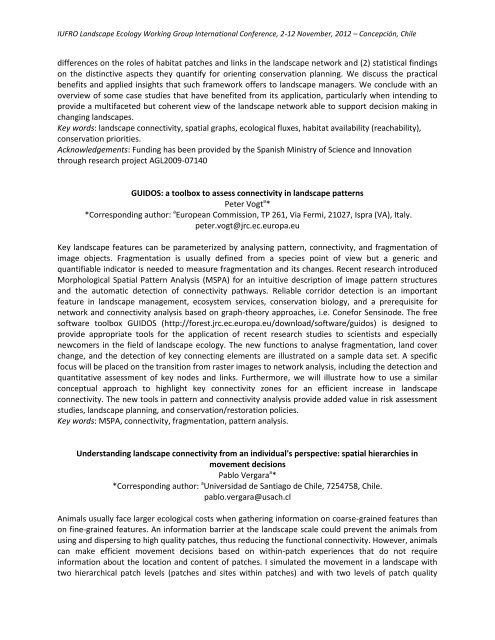BOOK OF ABSTRACTS - iufro landscape ecology conference
BOOK OF ABSTRACTS - iufro landscape ecology conference
BOOK OF ABSTRACTS - iufro landscape ecology conference
You also want an ePaper? Increase the reach of your titles
YUMPU automatically turns print PDFs into web optimized ePapers that Google loves.
IUFRO Landscape Ecology Working Group International Conference, 2-12 November, 2012 – Concepción, Chiledifferences on the roles of habitat patches and links in the <strong>landscape</strong> network and (2) statistical findingson the distinctive aspects they quantify for orienting conservation planning. We discuss the practicalbenefits and applied insights that such framework offers to <strong>landscape</strong> managers. We conclude with anoverview of some case studies that have benefited from its application, particularly when intending toprovide a multifaceted but coherent view of the <strong>landscape</strong> network able to support decision making inchanging <strong>landscape</strong>s.Key words: <strong>landscape</strong> connectivity, spatial graphs, ecological fluxes, habitat availability (reachability),conservation priorities.Acknowledgements: Funding has been provided by the Spanish Ministry of Science and Innovationthrough research project AGL2009-07140GUIDOS: a toolbox to assess connectivity in <strong>landscape</strong> patternsPeter Vogt a **Corresponding author: a European Commission, TP 261, Via Fermi, 21027, Ispra (VA), Italy.peter.vogt@jrc.ec.europa.euKey <strong>landscape</strong> features can be parameterized by analysing pattern, connectivity, and fragmentation ofimage objects. Fragmentation is usually defined from a species point of view but a generic andquantifiable indicator is needed to measure fragmentation and its changes. Recent research introducedMorphological Spatial Pattern Analysis (MSPA) for an intuitive description of image pattern structuresand the automatic detection of connectivity pathways. Reliable corridor detection is an importantfeature in <strong>landscape</strong> management, ecosystem services, conservation biology, and a prerequisite fornetwork and connectivity analysis based on graph-theory approaches, i.e. Conefor Sensinode. The freesoftware toolbox GUIDOS ( http://forest.jrc.ec.europa.eu/download/software/guidos) is designed toprovide appropriate tools for the application of recent research studies to scientists and especiallynewcomers in the field of <strong>landscape</strong> <strong>ecology</strong>. The new functions to analyse fragmentation, land coverchange, and the detection of key connecting elements are illustrated on a sample data set. A specificfocus will be placed on the transition from raster images to network analysis, including the detection andquantitative assessment of key nodes and links. Furthermore, we will illustrate how to use a similarconceptual approach to highlight key connectivity zones for an efficient increase in <strong>landscape</strong>connectivity. The new tools in pattern and connectivity analysis provide added value in risk assessmentstudies, <strong>landscape</strong> planning, and conservation/restoration policies.Key words: MSPA, connectivity, fragmentation, pattern analysis.Understanding <strong>landscape</strong> connectivity from an individual's perspective: spatial hierarchies inmovement decisionsPablo Vergara a **Corresponding author: a Universidad de Santiago de Chile, 7254758, Chile.pablo.vergara@usach.clAnimals usually face larger ecological costs when gathering information on coarse-grained features thanon fine-grained features. An information barrier at the <strong>landscape</strong> scale could prevent the animals fromusing and dispersing to high quality patches, thus reducing the functional connectivity. However, animalscan make efficient movement decisions based on within-patch experiences that do not requireinformation about the location and content of patches. I simulated the movement in a <strong>landscape</strong> withtwo hierarchical patch levels (patches and sites within patches) and with two levels of patch quality


